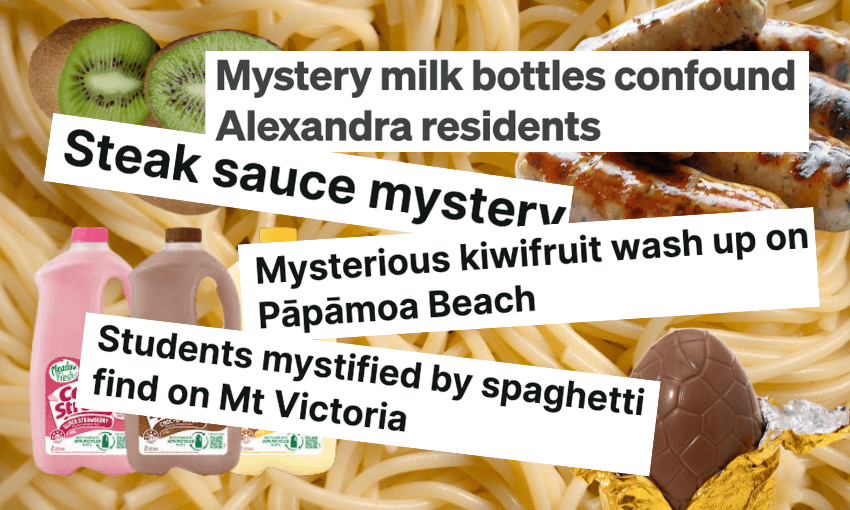Alex Casey talks a stroll through headlines detailing hundreds of beached kiwifruit, dozens of mailbox sausages and one giant mystery ham.
Nothing awakens the soul quite like a bit of weird food popping up somewhere it shouldn’t be. Last year, I was aghast to find a topless mince pie sitting stoically in the middle of my lawn. Even just last week, I discovered a Hansel and Gretel-esque curious trail of rainbow-coloured, candy-coated popcorn leading up our driveway. I was so delighted by the novelty I didn’t even care that we are evidently being stalked by the Child Catcher from Chitty Chitty Bang Bang.
As recent history would suggest, I am not alone in this. Food dumps are happening everywhere, and in much larger quantities, all the time. Earlier this month, a Napier family went public with their harrowing story of being mercilessly targeted by packets of steak sauce left outside their home. Tamatea resident Lisa O’Connor detailed the “out there” experience of finding more than a dozen packets of Gregg’s Steak Sauce in her mailbox over the last two years.
While the perpetrator is suspected to be someone in O’Connor’s “outer family”, she said she was not taking any chances with the high-stakes steak sauce. “We haven’t eaten any of them because A: we are not big fans of steak sauce ourselves and B: we don’t really trust whatever is in it because we don’t know where it is coming from,” she told Hawke’s Bay Today. “We have thrown all the other ones away because they were just taking up so much room in the pantry.”
These discarded Gregg’s Steak Sauce packets join a plethora of other mystery food dumps in headline heaven. Let us look back at some of the more bizarre examples of the form.
Mystery beach cheese (September 2008, Breaker Bay, Wellington)
It’s like Taylor Swift would say: cheese on the beach, weird but fucking beautiful. In 2008, Wellington City Council received reports of an object originally believed to be a “huge piece of cheese” on the shore at Breaker Bay. Some believed it to also be ambergris, otherwise known as very expensive whale vomit, but after a “scratch-and-sniff test” it was found to be “either industrial fat or lard”. We remain waiting patiently for our beloved beach cheese to reach the shore.
Mystery spaghetti dump (March 2018, Mount Victoria, Wellington)
At 6.30am March 2, 2018, Wellington City Council received a chilling call reporting a “pasta attack” on Mount Victoria. Several kilograms of cooked spaghetti were found by a group of students out for a morning run. Jack Christopher Anderson was first on the scene of the al dente attraction, and told the NZ Herald “our first reaction was to either eat it or take a photo or two”.
Given that the pasta was cold upon discovery, and one runner reported it being “smelly” to the nose, the Wellington public health team advised people to not eat the spaghetti. The poor Mount Vic park ranger told The Herald that the whole saga “left a bad taste in his mouth”, and the oodles of noodles were quickly disposed of, never to be spoken of again.
While we still don’t know who is responsible, a thrilling pasta parallel emerged just last year in New Jersey in the United States. Residents of Old Brook were aghast to find more than 200kg of pasta dumped by a local brook. Crucially, this pasta was uncooked, but had softened due to recent rainfall. Public works removed 15 wheelbarrows’ worth of pasta, in an operation dubbed “Mission Impastable”.
Mystery muesli bars (August 2016, Blenheim)
In 2016, a so-called “cereal prankster” went on a spree, leaving muesli bars in mailboxes for more than a year. Despite pristine appearances, the wrapper contained a small roll of cardboard, rather than any sustenance. “I picked it up from the letterbox and thought, ‘sweet, a free muesli bar,’” local Paul Negrerie told Stuff. “But when I opened it up it looked weird… I thought it was an advertisement for a muesli bar or a gift, but it was just cardboard.”
A Weight Watchers spokeswoman told Stuff that the bars were, unfortunately, not part of a viral guerrilla marketing strategy. “Although it certainly exposes people to the brand, we think that they might like the bars more if they got to experience the deliciousness that’s normally inside,” she said. To this day, nobody knows who was leaving mystery muesli bars in Blenheim, but I could certainly go an apple crumble muesli bar (four smartpoints) right about now.
Mystery fruitcake dump (August 2019, Dunedin)
Not sure a single cake meets the “dump” criteria here, but this story is too sweet to pass up on. In August 2019, a freshly baked fruitcake was discovered in a postage-paid bag, with no address or sender details. New Zealand Post Coastal Otago area manager Craig Strathern told the ODT it was “beautifully baked and wrapped”, likely by “someone like my mum”.
“I have no idea where it came from or where it’s going to,” he said. “I’m just so gutted that it’s not going to get there unless we do something.”
Just a few days later, the icing on the cake: Hilda Chalmers, “a very proud nana”, saw the story and got in touch with Strathern directly. “The cake was for my grandson who is at university in Christchurch,” she said, explaining that she writes the address and return address on sticky labels due to a tremor in her hands, and they likely fell off in transit.
Strathern put the parcel on a New Zealand Post truck straight to Christchurch, where Chalmers’ grandson Scott was beginning his studies at the University of Canterbury and undoubtedly awaiting a delicious slice of spicy fruit cake. It is said to have arrived at lunchtime the very next day. “A fantastic result,” Strathern said.
Mystery jamón ibérico dump (March 2022, Hobsonville Point, Auckland)
Ham-fisted by me in more ways than one to include my own story here, but the jury is still out on how the hell a leg of succulent jamón, imported from a tiny village in Spain and boasting a street value of nearly $2,500, ended up in a bush in the Auckland suburb of Hobsonville Point. Found by local resident Rafael Fonseca on his dog walk, he was so alarmed by the find that he called 111.
After a post in the Hobsonville Point Facebook group yielded nothing but a few bad puns, Fonseca brought home the bacon, much to his dog Sudo’s delight. He rang the police again (105, not 111), but they were as confounded as anyone. “There’s no clues, there’s no leads, this is one of the most unusual things we have ever had to deal with”, they told him.
Years on and one hard-hitting investigation later, there are still no answers as to who dropped their big expensive leg of ham in Hobsonville Point. Jamón importer Joan Farras described the situation as “silly” and “like a Monty Python thing”, while Hobsonville socialite Erin Simpson assured us “it’s not my ham”. But the last word goes to Sir Peter Leitch, aka the Mad Butcher.
“It is strange,” he said. “But don’t forget: we are living in strange times.”
Mystery mailbox sausages (2022-2023, Waiheke Island)
“The first sausage arrived in the summer of 2022” is the perfect opening sentence to this unwieldy sausage saga from Stuff. Waiheke resident Jacob Coetzee thought the first sausage he found in his mailbox was left by a passing drunk, until he kept receiving snags regularly for months. After sending a picture to a group chat, the plot thickened. “Some of them had been sausaged as well,” he said. “That’s when we realised we had a serial sausager on the island.”
The pattern of sausaging was erratic, but continued well into 2023 (over Christmas 2022 a sausage even arrived in wrapping paper). “You never know when the strike will happen but when it does, everyone gets struck,” Coetzee said. “Nobody’s letterbox is safe.” They were thought to be Hellers pre-cooked snags, and a Countdown representative told Stuff “we’ll continue to keep a close eye on the small goods section in-store and report any suspicious activity.”
Nobody knows who is behind the persona now known as The Surfdale Sausager, although their vegetarian-unfriendly vigilantism appears to have calmed. Some-time Waiheke resident and natural suspect the Mad Butcher was “flabbergasted” by the mystery, but was yet to be sausaged himself. “Who’s buying sausages just to put them in people’s letterboxes? Amazing.” As a very wise man once said, we are living in strange times.
Mystery Uber Eats deliveries (March 2023, Torbay, Auckland)
You’d think a surprise Uber Eats delivery might be a welcome treat, but last year it quickly became a “puzzling” nightmare for Jake Scott, a resident of the North Shore suburb of Torbay. Beginning with pot noodles, some milk and chocolate arriving at his door at 2am on a Sunday, he then received more than 20 more deliveries from UberEats over the course of just four days, Scott told Stuff.
They extended late into the night, even following him outside of the home – Dominos garlic bread was sent to his workplace, and the 27-year-old even had a “hot big breakfast” from the Coffee Club delivered during his interview with Stuff. “Not gonna lie, I have been eating some of it,” Scott said. “When free food shows up, of course you’re gonna eat it.”
Other food items included Weetbix, a bag of chips, an apple and an onion, but the more bizarre items included “a 100-watt soft white Philips light bulb, tampons and a single rose with an unsigned note saying ‘I love you’”. A range of names were revealed to be behind the mystery, including John P, Alofa T and Mr X. Scott had just one message to the “creepy” culprit:
“Can you send some KFC?”
Mystery kiwifruit dump (February 2023, Pāpāmoa Beach, Bay of Plenty)
More than 40 kiwifruit were found at the high tide line at Pāpāmoa East beach in February 2023, one of the most powerful years on record for weird food dumps. “It appears to be a recent event, as some of the kiwifruit are still in good condition,” a beachgoer told the Bay of Plenty Times. Varying in size from “quite large to very small”, none of the kiwifruit were reported have stickers on them – nude beach? The Spinoff is awaiting comment from those big Zespri kiwifruit mascots, who won’t sway their way out of this one.
Mystery flavoured milk dump (July 2024, Alexandra, Central Otago)
In July, Alexandra residents were confronted with a calcium-rich conundrum unlike any other. Bottles of flavoured milk, spanning chocolate, banana, strawberry and coffee, were being left on the pump at the local petrol station on MacLearn Road. “Sometimes they leave behind a single bottle,” wrote RNZ’s suitably breathless reporter Soumya Bhamidipati, “while other instances have seen as many as six bottles appear at once.”
Local legend Poppy Prendergast told RNZ she had been tracking the mystery milks for months, and had a fair few theories as to their origins. “The frequent fuel stops, you know, this must be a delivery person, they’re coming back and forth,” she said. Prendergast also posited the gender of the culprit. “Look, I hate to say it but I think it’s got to be a man. I’ve never met any woman that drinks that much flavoured milk.”
A day later, security footage revealed a thrilling lead in the case. “The main culprit, I believe, is a delivery driver,” said RD Petroleum chief executive Craig Fitzgerald. Describing how “he rocks up” every morning and leaves the bottles after getting his diesel, Fitzgerald was still none the wiser as to his motive. “It’s not like he’s leaving full bottles as a gift, they’re sort of half-drunk so I really don’t know why he leaves them,” he said.
“It’s bizarre.”





